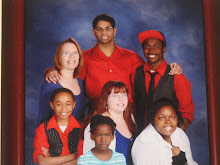Claudia, at "Never a dull momen"t wrote a great post on residential placements. Residentials or RTCs are something I alternately think a lot about and then try to push out of my mind. Most of Fiona's life has been in a residential placement. She was in one for 2 years before I met her and then placed in a foster home. I was assured at our many pre-adoption meetings that although the RTC placement was something to consider, it wasn't really where the child was "here and now" I was in uncharted waters and in my Polly anna way I made the assumption that the placement was due to the severe trauma that Fiona had gone through and that she had been helped and stabalized. All the professionals I spoke with stressed what a great thing it would be for the 3 siblings to reunite and live together. All I could see was that our home could do that. No one suggested that the siblings might have been terrorized by Fiona when she was raging--or that one of them might even NOT want to live with her. This never crossed my mind as I had no life experience that would indicate such feelings were even possible.
The agency moved Fiona in to our home hurriedly. We found out afterwards that things were going badly at the foster home due to Fiona's behavior (though at the time the agency sort of led us to believe that they had other issues regarding the foster home.) It was not long--less than 2 months before really serious issues began to surface. And by that time, Rob was here as well, and their sister Krystal was visiting with placement as a goal.
I have written about the hard days that led to the disruption of Fiona from our home before and I can't make myself do that again. I can say it was not lightly done. It was the most painful decision I have ever made. It came about after 2 long term hospitalizations and multiple medical professionals determining that Fiona could never successfully live safely in a traditional home setting. I love my daughter, but I can not be awake 24/7 I also have other children to consider and did not want to traumatize them further. This wasn't a case of putting bio kids in front of adopted kids as my whole family is built through adoption. It wasn't a case of saying a "damaged" child was not as good as the others. As readers know, my Chet is autistic and he has significant issues but they were being ramped up and leading to self harm on his part with the constant raging, destruction and danger that Fiona at home was causing.
I was also told by the professionals that if I proceeded with the adoption that although my daughter would have a secondary state subsidy for life, that it would be much harder to access the type of care that she needs in order to stay safe. So eventually, we stopped working toward adoption with the clear understanding that in my heart, Fiona is my daughter and our emotional commitment to her endures. That she is part of our family but can't live in our family,and that she is known and loved for who she is by each one of us.
Which sounds all sunshine and roses and really isn't. If every RTC was like the Great School in the Big City, maybe it would be. But our experiences have varied wildly in our access to her, and our acceptance by the schools as important in her life. There have been schools and workers who have told me I have no business inquiring after my daughters health because she is not legally mine. That my wish to have visits more frequently is not relevent because of this. There have been times she was hospitalized and RTC staff never told us.
And I have seen many of the points that Claudia raised in her article on residential facilities be true in our experience and in Fiona's. In addition to those negatives, I would stress that I think it damages attachment possibilities by the very nature of institution life. For Fiona on the one hand RTC life is "safe" both literally and figuratively. There is always someone there to make sure she doesn't hurt herself, to call the authorities if she bolts and takes off into traffic etc. But it is also safe because people come and go and it isn't really necessary or emotionally healthy to really get close to people--you know they will be gone in a year or so. And some RTC's will not allow kids to maintain any contact once they have moved, even if they want to. One such place said they did this because no one would ever move forward and would always be looking back, if they let school alumni correspond with letters or phone calls.
I think over time, that has greatly contributed to Fiona's type of attachment to us. Essentially, she loves us and I know that. But we are not foremost in her thoughts if we are not standing in front of her. Faced between finishing her picture she is drawing and making a weekly call to us she might (and has) just as often chosen to continue drawing than to talk with us. Admittedly there are cognitive issues and mental health issues in play as well, but I also have to believe that residential living also plays a role.
I know I did the only thing I could for Fiona. I just wish there had been -- that there was today -- a better system. We are both more than a little broken from the experience.
Friday, March 23, 2012
Residental Placement thoughts
Labels:
adoption,
behaviors,
disruption,
family,
Fiona,
foster care,
mental health,
relationships,
trauma
Subscribe to:
Post Comments (Atom)





No comments:
Post a Comment